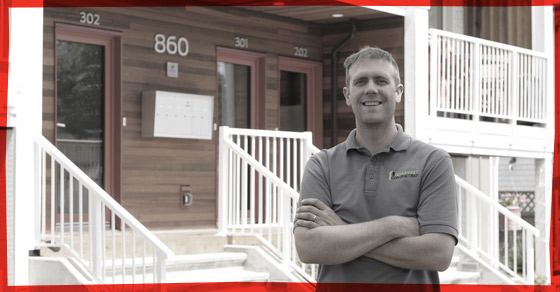European green building standard takes hold in BC

About this story
- Organization
Bernhardt Contracting - Region
Victoria, BC - Area of impact
- Type of investment
Loan product
That willingness to put their money where their mouth is in terms of environmental sustainability is what draws us back to them every time. It’s incredible to have that kind of ally. Mark Bernhardt, President, Bernhardt Contracting
Mark Bernhardt lives in a house that consumes up to 90 per cent less heating and cooling energy than the norm, that never gets drafty in winter or overheated in summer, and that is so quiet he wouldn’t know if there was a storm outside unless he opened the blinds.
Mark’s family home is among the first examples in BC of a Passive House (or Passivhaus in the original German), a European-pioneered building standard that uses key elements of construction and design to dramatically improve environmental performance. It’s a trend that is catching on fast in the province and Mark should know. Not only does he live in a Passive House, he builds them too. As president of Bernhardt Contracting, his company was behind the first multi-unit Passive House building on the open market in Canada.
“My first career was in environmental impact assessment for the oil and gas industry,” says Mark. “When you apply that same methodology to a building, you find that energy use has by far the biggest impact, much more than any materials you use. So if you’re going to build greener homes, the easiest way to make the biggest difference is to go after the biggest piece of the pie.”
Passive House buildings are air tight, they have super insulation and quality components like triple-pained windows and heat-recovery ventilation systems that provide the buildings with fresh air without letting any heat out. This means that heating and cooling costs are dramatically reduced.
Mark Fulmer, Vancity business account manager on Vancouver Island, manages the relationship with Bernhardt Contracting and approved the financing on North Park, the company’s first Passive House project, a six-unit condominium building. He’s since learned a lot about the science behind reducing the amount of energy that buildings consume.
“Passive House uses different techniques for the framing of walls”, he says. “In a standard two-by-six wall you would have a piece of wood that goes all the way from the inside of the wall to the outside. But wood is not a great thermal insulator so in Passive House construction they offset the framing. This means there are no thermal bridges allowing heat to escape through the walls.”
Following the success of North Park, where the units were all sold in a matter of weeks, Vancity provided financing for Bernhardt to purchase two lots in Victoria West and, at the beginning of 2016, construction financing of $875,000 and $1, 370,000 for two Passive House duplexes.
Tobi McKay, Vancity analyst in community business, did the due diligence and risk analysis for the deals.
“The account manager is the one who provides the background information that the analyst wouldn’t be able to see from the financials,” explains Fulmer. “We’re always looking for construction projects that push the envelope on environmental performance so we were prepared to go further than normal with Bernhardt Contracting. I provided Tobi with all the details about what made this project special and then she did the work of making sure the numbers made sense for both parties.”
Bernhardt says he acknowledges the effort Vancity has put in to support the work he’s been doing.
“One of the things that we really appreciated from Vancity is that they effectively took a risk on us,” he adds. “We were a relatively inexperienced developer and a relatively small building company. That willingness to put their money where their mouth is in terms of environmental sustainability is what draws us back to them every time. It’s incredible to have that kind of ally.”
The Bernhardt family’s commitment to Passive House extends beyond building homes. They’re working hard to educate other builders and Mark’s father, Rob, is the CEO of Passive House Canada, a national non-profit professional association which advocates for the Passive House high performance building standard.
“We do public speaking on Passive House standards and our talk has changed somewhat over time,” Mark Bernhardt says. “At first, we’d talk most about the science, the numbers and the environmental benefits. The nerdy number stuff is still interesting, but now we tend to talk more about the comfort of living in one of these places. It really improves your quality of life because you’ve got this quiet, fresh air sanctuary inside your home. Personally, I’ll never go back to living in a conventional house.”